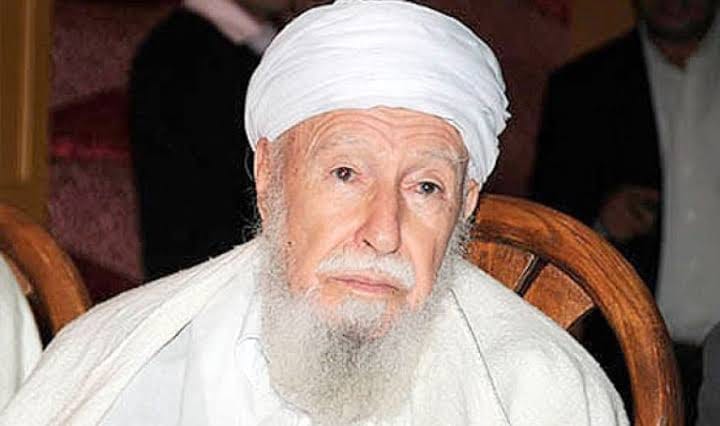The Ministry of Religious Affairs and Endowments announced a short while ago the death of Sheikh Mohamed El-Taher Ait Eljat.
And a statement by the ministry said: Sheikh Muhammad al-Taher Ait Ialjat, Chairman of the Ministerial Committee for Fatwa and the National Committee for Crescents and Shari’a Times, has passed away.
Sheikh Muhammad al-Tahir Ait Ialjat was born in the village of Thamoukra Bani Aidil in 1917. He memorized the Holy Qur’an in his hometown in the Zawiya of his grandfather, Sheikh Yahya al-Aidli. Ottoman Empire near Constantine, and he studied there until he became well versed in jurisprudence, linguistic sciences, literature, and mathematics.
The sheikh memorized the Noble Qur’an at the hands of his father when he was eleven years old, then he entrusted it to three of the sheikhs of Thamkara, the first of whom was Sheikh al-Salih Oqasi, “a specialist in the ten recitations,” who received something from it in addition to the principles of Sharia and grammatical sciences, and the second of them was Sheikh Muhannad, Ali and al-Tayyib. The third of them is the good Sheikh Yaturghi. After that, and as confirmed by his student Muhammad al-Saghir bin Laalam, his father attached him to the corner of Sidi Ahmed Ouyahia in Amalou, which is not far from Thamkara, and he was 12 years old. Al-Khayari, who was an authority in Maliki jurisprudence and in the readings, and the second was the scholar Sheikh Saeed Al-Aygri, one of the founders of the Association of Algerian Muslim Scholars, in the various arts of science such as jurisprudence, language, morphology, rhetoric, astronomy and arithmetic, then he set out on a journey to the corner of Sidi Sheikh Belhamlawi in the Ottoman Valley near Constantine, where he completed his legal studies there. From jurisprudence and language, as they transcended to other sciences such as arithmetic and astronomy, in addition to human sciences such as history, geography, and others, at the hands of five sheikhs, all of whom are olive, three of whom are Tunisians: Sheikh Misbah Al-Huwaidaq, Sheikh Muhammad and Sheikh Mahmoud Qaribaa, and two Algerians: Sheikh Saeed Al-Alawi and Sheikh Ahmed Al-Biskari .
Teaching career
He returned to his village, Thamaqra, when he was twenty years old, an integrated scholar who was qualified to assume the seat of professorship and ascend the chair of the sheikhdom to teach. So this ancient institute, which was founded by the divine scholar, the righteous saint, Sidi Yahya al-Eidly, in the ninth century AH, resumed its activity in memorizing the Noble Qur’an and teaching Islamic and linguistic sciences, readings and arithmetic. From neighboring regions such as M’sila, Bordj, Setif, Tizi Ouzou and its environs. Sheikh Al-Taher established a special system for his corner similar to the systems of major Islamic institutes, and his students would join Zaytuna with more knowledge and literature that supervised their corner and the one in charge of it.
After the good reputation that the sheikh left in the psyche of the students, his grandfather’s corner, Sidi Yahya Al-Eidly, turned into a sanctuary and refuge for many of those sought by the colonial authorities, as they flocked to the corner, which had become a religious, social, and charitable institution open to all students and visitors.
Participation in the liberation revolution
He participated in the Algerian revolution, along with the rest of the students of the corner of Sidi Yahya al-Eidly, who all joined the ranks of the mujahideen after the French occupation blew up their corner in August 1956 AD. He traveled to Tunisia at the end of the year 1957 AD at the behest of Colonel Amiroush, who used to hold the position of judiciary in his army battalion, as well as settling disputes. Then he moved to Tripoli, Libya, where he was appointed as a member of the Liberation Front office there.
The sheikh denied
Meanwhile, France was watching him through its eyes, aides, and lackeys, so it decided to banish Sheikh Al-Taher from Thamkara in 1948, while his students and disciples tried to nullify this decision, so they formed – according to Professor Bin Laalam, who was one of them – a delegation to contact the leader of the roundabout, but the leader disowned him. Responsibility, and he answered them, “I have nothing in my hands.. Go to Ben Ali al-Shaif (the ruler by his order in the region).”
But the Sheikh received his banishment decision with his usual smile, with beautiful patience and reassuring soul, so he joined his exile in the corner of Sidi Said on the outskirts of Sadouq, and he stayed there for one year, honored and honored, as the students of this corner and the residents of the village considered the descent of the pure Sheikh in their hospitality as a blessing from God upon them.
The destruction of the French colonizer of the corner
After Sheikh Tahir Ait Ialjat returned to his hometown in 1937, he took over the teaching and education in the corner of Sidi Ahmed Ben Yahya in Amalou, and he used to provide lessons in teaching the Qur’an, the Arabic language and Sharia, until the year 1956 AD when the French army burned the corner.
Joining him and his students in the liberation revolution
Sheikh Ait Eljat participated in the Algerian revolution along with the other students of the zawiya, who all joined the ranks of the mujahideen after the French occupation bombed their zawiya (which was established in the ninth century AH) in 1956, because it had been calling for a revolution against it since the first occupation of Algeria. The sheikh described that era as golden because it was characterized by brotherhood, cooperation and sacrifices.
The beginning of Sheikh Ait Aljat was during his joining the ranks of the Liberation Army as a Sharia judge, as he used to move with a group of soldiers between the battalions in the villages and villages to look into the various issues that were presented to the citizens and the blessed revolution, and he ruled according to what God gave him success in that.
He moved to Tunisia and then Libya
He traveled to Tunisia at the end of 1957 at the behest of the martyr Colonel Amirouche, who used to assume the position of judge in his army battalion, as well as the settlement of disputes, as Colonel Amirouche assigned him to travel to Tunisia and supervise the educational activity of Algerian students there, then he moved to Tripoli in western Libya, where he was appointed A member of the Liberation Front office there, the Sheikh did his best until Algeria became independent.
The corner martyrs
The students of the corner participated, by order of their sheikh, Allama Tahir Ait Ialjat, in the great liberation revolution, the revolution of the first of November 1954, and from it more than 100 martyrs passed on to the supreme comrade, led by 4 officers of the National Liberation Army, and they are: Si Abd al-Rahman ibn al-Muwaffaq, Si Jomaa Ouikhlef (He was the first assistant to the sheikh in teaching), Si Suleiman Antwal, as well as Ismail Antwal and others.
After independence, in 1963 he returned to Algeria, and was appointed as a professor at the Oqba Ben Nafi High School in Algiers, then at the Amara Rachid High School in Ben Aknoun, until he was retired in 1978.
Secondary education after independence
After independence, in the year 1963 AD, he returned to Algeria, and was appointed as a professor at the secondary school of Oqba Ibn Nafie in Algiers and the secondary school of Amara Rachid in Ibn Aknoun until he was referred to retirement in 1978. Then, at the request of the Ministry of Religious Affairs, he returned to his mosque activity, to practice preaching and guidance lessons and Friday sermon in a mosque Al-Ghazali in Haydara and other mosques. The sheikh is considered one of the prominent members and one of the founders of the Islamic Call League in Algeria.
His writings
An audio recording of his explanation of the message of Ibn Abi Zaid al-Qayrawani.
Appreciation of the book “The Forum of the Original and Sub-Disciplined Evidences of the Traveler Fath Al-Rahim Al-Malik”, authored by Sheikh Muhammad Bey Belalam, an imam and teacher in Aulaf, Adrar Province.
The Anthology of the series, Explanation of Al-Muwatta, Explanation of the Order of Differences, Explanation of Matn al-Rahbiyyah, Explanation of Kitab al-Risalah by Ibn Abi Zayd al-Qayrawani, Explanation of Matn al-Risalah to the Chapter of Victims and other letters and books.
#Sheikh #Mohamed #ElTaher #Ait #Ialjt #passed #AlHiwar #AlJazaeryia
#oussama_boulegheb #elhiwardz #alakhibariat.xyz #elhiwar #elhiwar-en



